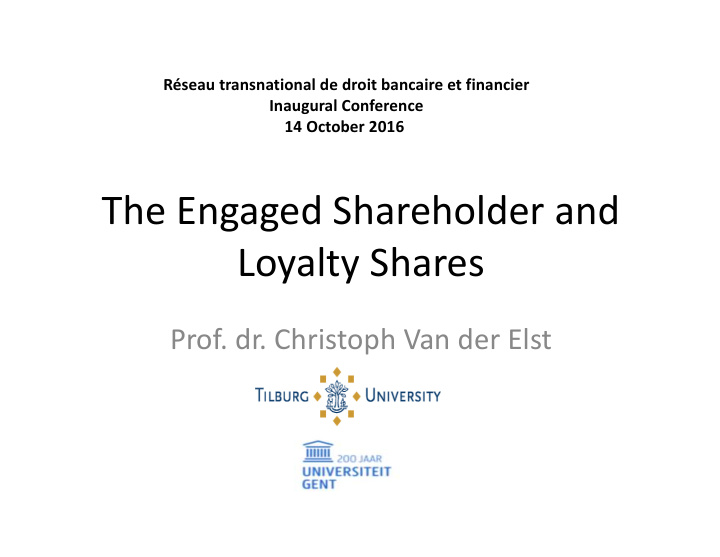



Réseau transnational de droit bancaire et financier Inaugural Conference 14 October 2016 The Engaged Shareholder and Loyalty Shares Prof. dr. Christoph Van der Elst
The Engaged Shareholder and Loyalty Shares • Long standing debate of one share one vote: – Pro’s: • Desirable for shareholder democracy • Shareholders can voice their opinion in proportion to their owned risk-capital • Control is less likely present, thus limiting entrenchment problems (perks, tunneling, monopolies, etc.)
The Engaged Shareholder and Loyalty Shares • Long standing debate on one share one vote: – Con’s: • Polically attractive but not optimal • Not sufficient nor necessary condition of shareholder democracy • Control can offer substitute for underdeveloped institutions • Current state of the art: – Deviation from OSOV helpful to promote long- term shareholder engagement
The Engaged Shareholder and Loyalty Shares • Research question: do loyalty shares increase the engagement of shareholders? • Assumption: engaged shareholders participate in AGM => granting loyalty shares increases attendance
The Engaged Shareholder and Loyalty Shares • France abolished multiple voting rights in 1933 • Introduction of system of double voting rights: – Articles of association can provide in double voting rights – for shareholders holding named shares – for more than two years (or longer period as provided in articles of association) • In 2014 system broadened in listed companies: – Automatic double votes for named shares held more than two years
The Engaged Shareholder and Loyalty Shares • Double votes are widely used: CAC 40 Companies with double voting rights 22 Companies with single voting rights 8 Companies that switched to single voting rights 3 Companies that switched to double voting rights 5 Companies that switched more often 2 • AGM 2007-2016
The Engaged Shareholder and Loyalty Shares AGM Double voting Single voting 2007 26 14 2008 27 13 2009 26 14 2010 26 14 2011 26 14 2012 26 14 2013 25 15 2014 25 15 2015 25 15 2016 27 13 All 259 141
The Engaged Shareholder and Loyalty Shares • Number of double voting rights in double vote companies 100% 90% 80% 70% 60% 50% 40% 30% Avg.% double voting rights 20% Avg. % single voting rights 10% 0%
The Engaged Shareholder and Loyalty Shares • Attendance at AGM 70% 68% 66% 64% 62% 60% Vote attendance 58% Share attendance 56% 54% 52% 50% 2007 2008 2009 2010 2011 2012 2013 2014 2015 2016
The Engaged Shareholder and Loyalty Shares • Attendance of shares in double voting vs. single voting comp . 70% 68% 66% 64% 62% Share attendance 60% "double voting companies" 58% Share attendance 56% "single voting companies" 54% 52% 50% 2007 2008 2009 2010 2011 2012 2013 2014 2015 2016
The Engaged Shareholder and Loyalty Shares • Attendance of shares in double voting comp. 100% 90% 80% 70% 60% Avg. attendance 50% double voting rights 40% 30% Avg. attendance single voting 20% rights 10% 0%
The Engaged Shareholder and Loyalty Shares • Intermediary conclusion: – Less than 20% shares have double votes + stable over time => low incentive system for shareholders – “share attendance” in single voting companies is higher => if any, low effect of double votes – But avg. attendance of double voting rights is higher => Loyalty shares have at best limited effect on engagement
The Engaged Shareholder and Loyalty Shares • Analysis with ownership • Use of double voting rights can be different in: – Controlled companies – Uncontrolled companies – Companies with significant shareholder
The Engaged Shareholder and Loyalty Shares Ownership and AGM years one vote double votes companies with controlling shareholder('s concert) 9,7% 13,3% companies with a significant shareholder 7,7% 19,4% companies with dispersed ownership 18,4% 31,5%
The Engaged Shareholder and Loyalty Shares Share attendance 80% 70% 60% 50% 40% 30% 20% 10% 0% one vote double vote one vote double vote one vote double vote companies companies companies companies companies companies with with with a with a with with controlling controlling significant significant dispersed dispersed shareholder('s shareholder('s shareholder shareholder ownership ownership concert) concert)
The Engaged Shareholder and Loyalty Shares Double votes and large shareholders # double voting rights # double controlling/sig attendance vote shares n. shareh. double votes double vote companies with controlling shareholder('s concert) 36,47% 85,10% 93,56% double vote companies with a significant shareholder 20,22% 56,86% 92,84% double vote companies with dispersed ownership 10,74% 72,19%
The Engaged Shareholder and Loyalty Shares Double votes and small shareholders not largest/concert not largest/concert shareholder shareholder attendance of attendance of double single voting shares voting rights double vote companies with controlling shareholder('s concert) 51,73% 72,31% double vote companies with a significant shareholder 55,21% 77,80% double vote companies with dispersed ownership 54,32% 66,52%
The Engaged Shareholder and Loyalty Shares Conclusion • Loyalty shares do not create engagement • Loyalty shareholders participate more in AGM • Large, controlling shareholders make use of system of loyalty shares • Loyalty shares are a power instrument, not an engagement instrument
Recommend
More recommend